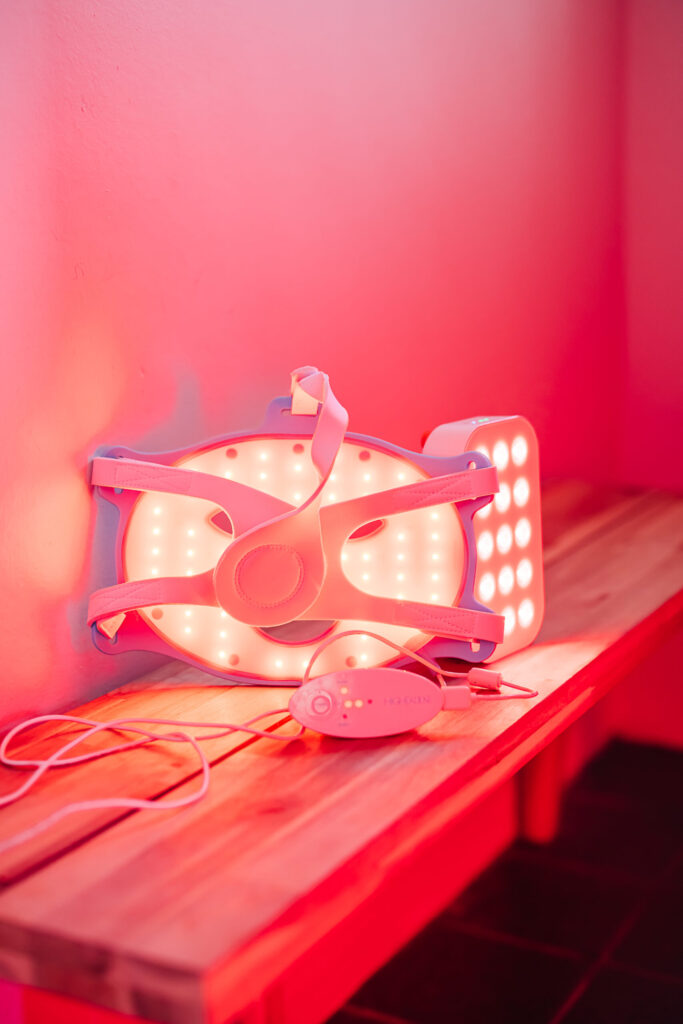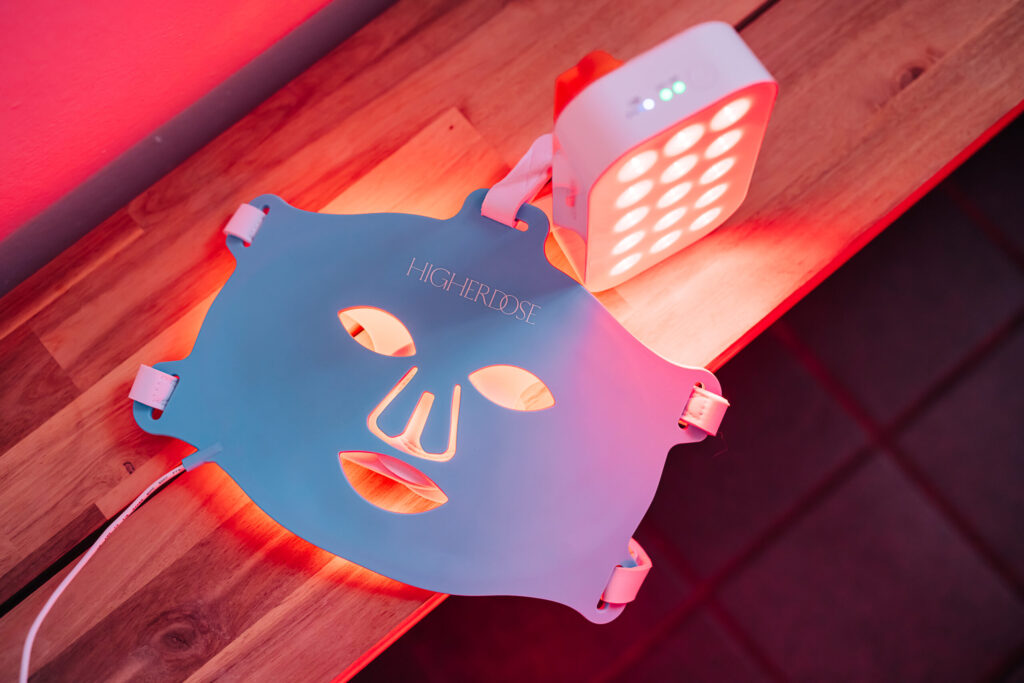I’m sharing some of my best tips for using red light therapy at home, including how to use red light and what to look for.
Hello friends! what are you doing I hope you had a wonderful weekend! Ours was full of fall fun and now we’re back to a week of trips and more events. Fall mayhem is in full swing, but I’m loving it.
When things are crazy, I try to stick to the pillars of my routine as faithfully as possible: daily walks, strength training a few times per week, meditation, hydration, nutrition, and my favorite biohacking tools like the red light.
If you’ve been hanging out here for a while, you know I’m a big fan of wellness gear. Between mom life, work, and workouts, anything that makes skin recovery, energy, and health easier (and more convenient) is a win.
One of the tools that has completely changed the game for me is red light therapy.
It’s one of those things that seems almost too good to be true – glowing skin, reduced inflammation, better recovery, deeper sleep – but the research behind it is pretty incredible. Today, I wanted to talk about what to look for in a red light device, how to use it effectively, and the pros and cons of home red light therapy (plus two of my favorite brands: Higher DOSE and Lumebox).

Red Light Therapy at Home: Device Guide and Tips for Optimal Use
What is red light therapy?
Red light therapy (also called low-level light therapy or photobiomodification) uses specific wavelengths of red and near-infrared light to help your cells produce more energy (ATP).
Think of it this way: your skin and tissues have tiny receptors that absorb light the way plants absorb sunlight. This energy boosts the performance of your cells – improving circulation, supporting collagen production, relieving inflammation and even speeding up muscle recovery.
What to Look for in a Red Light Therapy Device
Before investing in a home red light device, it helps to know what really matters.
Here’s what I recommend checking out:
1. Range of wavelengths
Look for a device that offers both red light (about 660 nm) and near-infrared light (about 850 nm).
Red light supports skin health and rejuvenation at a surface level, while near infrared penetrates deeper into muscles and tissues to repair and support inflammation.
2. Power density (radiation)
A good home device should deliver between 30-100 mW/cm² a few inches away from your skin. This ensures you get a therapeutic dose of light energy without long exposure times.
3. Treatment area
If you want to focus on your face or neck, a portable panel (like the Lumebox) is perfect.
If you want a full-body experience, a larger panel or wrap (like the HigherDOSE Red Light Blanket) gives you full coverage.
4. EMF levels
Always look for low EMF or zero EMF certification. Red light devices are generally safe, but since you’ll be using them close to your body, this is an important detail. Both HigherDOSE and Lumebox are designed with low EMF output in mind.
5. Ease of use
Make sure it’s something you’ll actually use.
The best device is one that fits easily into your daily routine – whether it’s a 10-minute session while journaling or watching TV at night.

How to use red light therapy at home
Here’s how to get the best results from your red light therapy routine:
1. Be consistent
Aim for 10–20 minutes per session, 3–5 times per week.
Like most things in wellness, consistency beats intensity. your results build over time.
2. Stay 6–12 inches away, depending on the device you are using
Keep the light close, but not too close. You don’t need to touch the board. this distance allows light to penetrate effectively without generating excessive heat. You can set the Lumebox to the Near Infrared setting to place it directly on the skin. I use it for back pain and muscle pain.
3. Aim for your goals
For skin health: Focus on the face, neck and chest.
For muscle recovery: Try post-workout sessions on sore areas or legs.
For relaxation or sleep: Use red light at night – it can help support melatonin production and better sleep quality. You may find that it gives you a boost of energy. In this case, use it in the morning or when you feel like you need a boost of energy.
4. Pairing with other recovery tools
You can reap the benefits by combining red light with magnesium baths, sauna sessions, or castor oil packs for a mini spa experience at home (you know I love that combination).

Pros and cons of red light therapy at home
Advantages
Convenient: No spa visits or appointments – use anytime at home.
Proven Benefits: May support skin health, muscle recovery, inflammation and mood.
Safe and non-invasive: No downtime or discomfort.
Easy to combine with other wellness routines: Fits seamlessly into your morning or evening routine.
Disadvantages
Upfront cost: Quality devices can be expensive, though they pay off over time.
Consistency required: You won’t see results overnight. it is cumulative.
Size limitations: Smaller devices process less surface area at once.
EMF therapy with red light therapy
Most high-end red light devices have minimal electromagnetic field (EMF) output, but it’s still smart to double-check.
Prolonged exposure to EMFs can contribute to anxiety and fatigue for sensitive individuals.
Here’s what I recommend:
Choose devices with low EMF certification (eg Higher DOSE and Lumebox).
Keep other electronics (like your phone or laptop) away during sessions.
My Favorite Devices
1. HigherDOSE Red Light Faves
If you love a comfortable, full-body experience, this is unbeatable. It combines infrared heat + red light therapy, enveloping you in warmth while helping your body to detox, recover and relax. It’s great for rest days, muscle recovery or nighttime jitters.
I use it almost everyday while running errands. I have noticed a huge difference in the quality and texture of my skin since I started using it!
I use it to promote hair health and growth! Bonus: it looks like a super cute baseball cap.
This is just like an extension of the red light face mask, but for your neck. It is extremely comfortable to wear and I have noticed reduced wrinkles.
Use code FITNESSISTA20 for 20% off. HigherDOSE favorites.
2. Lumebox Red Light
Ideal for face, neck and chest sessions, this sleek, portable panel fits easily into your routine. I like to use it in the morning while drinking my coffee or at night before bed for a quick skin boost and relaxation. I also use it in the near infrared setting for back pain, muscle pain or cramps.
It is low EMF, lightweight and extremely easy to travel with.
Use FITNESSISTA for $260 off Lumebox here.
Red light therapy is one of the simplest, science-backed tools to add to your wellness routine—especially if you’re focusing on energy, skin health, inflammation, or recovery.
Ok friends: do you like red light? What is one of your favorite home wellness tools?
xo
Gina
